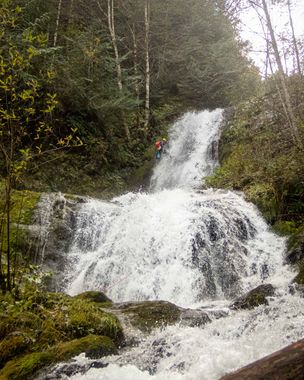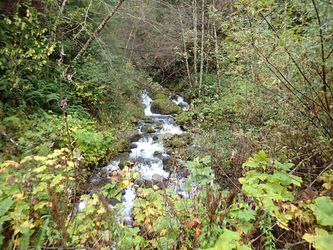Fisher Creek
| Rating: | |||||||||||||||||||||||||||||||
|---|---|---|---|---|---|---|---|---|---|---|---|---|---|---|---|---|---|---|---|---|---|---|---|---|---|---|---|---|---|---|---|
| | Raps:7-10, max ↨150ft
Red Tape:No permit required Shuttle:Required Vehicle:Passenger | ||||||||||||||||||||||||||||||
| Location: | |||||||||||||||||||||||||||||||
| Condition Reports: | 24 Oct 2020
"Likely a first descent of Fisher Creek as we found no other anchors or signs of passage. Had low expectations on water levels, but it turned out to b |
||||||||||||||||||||||||||||||
| Best season: | Apr-June, Oct-Nov
|
||||||||||||||||||||||||||||||
| Regions: | |||||||||||||||||||||||||||||||
Introduction[edit]
Fisher Creek is a tributary of the North Fork Tilton River outside Morton, WA. We suspect this creek is best in spring and fall when there's a good bit of water. The encroaching vegetation on the sides suggests that Fisher runs very low by mid-summer. If water levels are low, you might be better off continuing on up to Wallanding Creek further up the road.
- Use caution in the late season as there appears to be a lot of hunters in the area.
- Checkpoint is the place where FR 73 crosses Fisher Creek.
- Watershed: 0.75mi^2.
Directions[edit]
From Morton, follow WA-508 west for 3.8mi. Turn off on FR 73 passing a scary burned-out RV (this must be the bad side of Morton) for about 1.5mi up through a clear cut to a junction. Bear left here to stay on FR 73 for 1.2mi (road drops down to cross a bridge over the river) to Fisher Creek. There are pullouts near the creek with room for several vehicles. Road has a bunch of potholes, but probably okay for 2WD vehicles driven with care.
To reach the upper trailhead: continue north on FR 73 for 0.9mi to a Y-jct. Bear left for 0.2mi to another junction and left again on FR 7106 for 1.1mi. Park at the large obvious switchback on the road at about 2168' elevation.
Approach[edit]
From the switchback, head south, taking the path of least resistance down into a minor tributary creek that leads you down into Fisher Creek. The tributary some minor downclimbing but was largely open and brush-free. Approach to the creek takes about 5-10min. You'll drop in just below a minor 8ft drop just upstream. (No, there are no more drops upstream... we checked.)
Descent[edit]
Fisher Creek has a large number of short drops. You may end out doing more or less rappels depending your comfort level. The original team rappelled at least two drops just because they looked fun. There are a few pools, but mostly chest-deep or less.
The technical sequence begins with a downclimb DCR around some logs to the top of R1.
- R1: 15ft drop. Anchored on a tree on the right. Possibly could be downclimbed DCL.
- Logjam #1: downclimb or rappel 15ft far DCL against the canyon wall.
- Logjam #2: downclimb 20ft DCR. Worm your way over, under and through the jam.
- R2: 15ft. Thin tree DCL.
- R3: Two-tier falls: 35ft, 15ft. Rappel both from same anchor DCL. The lower tier has an interesting chute DCR that can be downclimbed.
- R4: Two-tier falls: 25ft, 20ft. Rappel both from same anchor DCR.
- R5: The creek swings right and narrows up, with the entire creek being channeled into a low-angle chute. A rope may be a good idea here for safety. There's an excellent tree for an anchor DCL right at the top of the chute. This section might be dangerous in high water. To bypass: climb up the ridge DCR and rappel from a tree. Also note the crushed culvert located high up DCR above the chute - presumably part of the old road.
- Below the chute are a series of 4-5 short drops all in a row. These can be rappelled or bypassed DCL. The last drop goes into a deep pool.
- R6: Two-tier falls. The upper section is maybe 60ft and a shorter lower one. Anchored from a tree DCR. Requires just about 100ft of rope to get to the bottom. Would be fun to run the full flow on this one. There is another short tier below which can be downclimbed.
- R7: Fisher Creek Falls This is a beautiful four-tiered waterfall which is the highest drop on the creek and the finale. It can be run in one rappel or broken up into a series of shorter ones. Requires about 150ft of rope from a tree anchor DCR at the top. The first tier is short (8ft) which goes into a hanging pool. It can be tricky to get out of in high flow. The second tier is about 50ft and kicks off a huge rooster-tail of water at the top. Expect to get a good drubbing. The falls spreads out on tier three (20ft) and forks around a small tree island on the fourth (20ft). Unfortunately, the same tree limits photographic options from the very bottom.
- R8: A short distance below the big falls, the creek drops about 15ft followed by a 30ft ramp. While it'd be fun to rappel the whole thing in one go, several trees had fallen over the creek making the first tier annoying to access. We exited the creek, pushing through the bushes, to a thin tree DCR which we used to rappel back into the creek (~35ft). Might be possible to downclimb here in drier conditions.
Beyond this point, there are no more technical obstacles, but the creek becomes rather jungle-y / overgrown.
Exit[edit]
From the final rappel continue downstream about 10-15min to the road. Alternately, exit DCR up onto the ridge when you can. Passes through open forest and follow the nose down to the road. Declare victory.
Red tape[edit]
None.
Beta sites[edit]
Trip reports and media[edit]
Background[edit]
Fisher Creek was first descended in Oct 2020 by Kevin Clark, Wade Hewitt, Lisa Ripps, and Wim Aarts.

